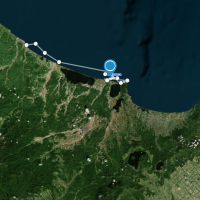D1のLさんが,年末に行った安定同位体分析について報告してくれました!
ーーー
Fieldwork is a primary component of the Ocean Mammal Team. However, only the data collected in the field is not nearly enough to comprehensively determine the biological and ecological characteristics of marine mammals. To investigate the diet, food source, and trophic status of baleen whales and pinniped species, Ocean Mammal Team members conducted stable isotope analysis at the CER from 28th Nov to 2nd Dec 2022.
Previous blogs about the stable isotope analysis on the Antarctic minke whales are as below,
https://hokkaidocean.sakura.ne.jp/2021/03/28/rep-2/
https://hokkaidocean.sakura.ne.jp/2021/12/15/rep-17/
The principle of stable isotope analysis is based on the saying ‘you are what you eat’! Among commonly used isotopes in ecological research, carbon isotope (13C) can reflect the temporal and spatial variations in diet and movement based on the isotopic composition of primary producers in the area of foraging. Another highly used isotope, nitrogen isotope (15N), is known to increase with each trophic level and is highly used to reconstruct food webs and trophic levels. Owing to the variability in tissue-specific metabolic turnover rates, stable isotopic values in different tissues can reveal the foraging ecology of a species across medium to long time scales. Continuously growing tissues, such as pinniped whiskers and baleen plate, can provide information about foraging activities for a temporal span according to their growth rates. Generally, whiskers of some pinniped species (e.g., northern fur seal, Steller sea lion) and baleen plates can reflect the changes in food resources or diet during the formation of these inert tissues (timescale: over the years). In comparison, metabolically active tissues, like the liver and muscle, can depict foraging ecology over weeks and months because of their high protein turnover rates.
The samples we analyzed include baleen plates of minke whales, whisker, liver, and muscle tissues of pinniped species, and some prey species potentially utilized by marine mammals. The stable isotope ratios in baleen plates may inform us about temporal changes in their diets and help to determine their ages. While for pinniped species, various tissue types are expected to depict a time-integrated foraging ecology and habitat use of studied species. Combining the isotopic information of prey species and marine mammals, we also look forward to understanding the trophic interactions between species and elucidating their resource use and diet composition.
Samples were dried, pre-degreased, and ground into powder before weighting and measuring stable isotope ratios in the Center for Ecological Research. Each sample was weighed about 0.4~0.6μg and sealed in a tiny tin cup (5mm×9mm). Then, we used the Elemental Analyzer-Isotope Ratio Mass Spectrometry (EA-IRMS) to determine the stable isotopic signatures with the help of technicians and professors in the lab of the Center for Ecological Research. Unlike the previous analysis, we practically operated the instruments, which deepened our understanding of the measurement of stable isotopes. It is so appreciated that the members of the Center for Ecological Research generously helped us with the experiment and provided valuable advice throughout the process!

According to the preliminary results, individual variability of stable isotopic compositions was observed in northern fur seals and Steller sea lions. Moreover, variations of stable isotopic compositions in different tissues of the same species were determined. Hereafter, we will further explore the results and try to provide a comprehensive understanding of the foraging ecology and habitat use of marine mammals in the marine ecosystem. Stay tuned to learn updated information about our study!
Reference:
Fry, B. (2006). Stable isotope ecology (Vol. 521, p. 318). New York: Springer.
Mitani, Y., Bando, T., Takai, N., & Sakamoto, W. (2006). Patterns of stable carbon and nitrogen isotopes in the baleen of common minke whale Balaenoptera acutorostrata from the western North Pacific. Fisheries Science, 72(1), 69-76.
Zimmo, S., Blanco, J., & Nebel, S. (2012). The use of stable isotopes in the study of animal migration. Nature Education Knowledge 3 (12): 3.









